Introduction
Regardless of the size of your company or the service you're providing, the likelihood is high that you won't be able to do it all. Some of the biggest companies globally, like Google, Facebook, and Apple, outsource their development and IT services, for example, and this practice is only growing in popularity.
Many businesses have started to use this model to help them accelerate their growth or accomplish an objective they don't have in-house skills for. So if you're in the market to create a new mobile app, or are working on a complex IoT service, consider your options carefully.
You could build your own in-house team, outsource the project entirely, or even proceed down an outstaffing route. But how do you know which model to choose? Let's have a look at some of the main differences between outsourcing and outstaffing to help you make an informed decision.
1. What is an Outsourcing Model and How Does It Work?
One of the most crucial choices for your business is outsourcing your IT, which can be complicated. Even though you may know what you want to achieve, choosing how to execute it can be challenging.
In general, outsourcing is used when a concept comes to mind but cannot be carried out on your own. You don't want to bother setting up an entire IT department; instead, you just want to present your idea to another company and have an application or website ready in exchange for a fee.
For company founders who want to begin the software development process as soon as possible and avoid delving deeply into the technical aspects of the projects, outsourcing is the ideal solution. In this case, it will be good to find an outsourcing provider. For individuals who don't have enough time to dedicate to project development and who don't want to cede control of their company, it's a good solution. Small businesses that just want to try out new ideas can also benefit from outsourcing companies because it allows you to test your idea and then determine whether or not it has to be developed further.
2. Pros of Outsourcing Software Development
2.1 Cost-efficiency
Because they are paid hourly, outsourcing teams are more economical. You only have to pay for the time they actually spend working on a project. Additionally, there is no requirement to spend money on hiring, office supplies, technology, or other onboarding procedures.
2.2 Responsibility of code quality is on vendor
Vendors should be in charge of quality control and making sure the coding adheres to your project's specifications. At the client level, you are not required to provide any daily management outputs. And that's a major benefit.
2.3 No management efforts
Turnkey service is what vendors offer you. The IT personnel working on your project—from your internal staff to their outsourced team—is coordinated by them. They oversee communication, deliverables, quality control, and schedules.
2.4 Wide choice of talent experts
As already said, an outsourcing company gives you access to a vast network of experts on every continent with varied degrees of experience. This is extremely advantageous for the healthcare sector because companies frequently need specialized knowledge or a narrow range of business experience, which can be challenging to get locally.
2.5 Reliability & speed
The majority of businesses aim for quick development in order to launch their products as soon as possible. Outsourced teams can produce high-quality software considerably faster than in-house teams since the onboarding process is so quick. In conclusion, outsourcing is a great way to speed up development.
3. Cons of outsourcing software development
3.1 More expensive than outstaffing
Costs are associated with all of that management and turnkey service. You must pay by the hour under the terms of the outsourcing agreement for the assistance of the outsourced IT staff members and the project management team charged with overseeing your account. For a straightforward assignment, many suppliers may charge you more per hour, but when they anticipate working with you again on bigger tasks in the future, they may reduce their fee.
3.2 Miscommunication risks
Working with remote teams has a number of risks. Miscommunication brought on by time zone differences and linguistic and cultural barriers is one of them. Furthermore, it is impossible to communicate face-to-face.
3.3 Limited visibility
Less project transparency is implied by outsourcing, however depending on the goals of the company, this could be advantageous or detrimental. Employers can concentrate more on their business thanks to outsourcing because there are less interruptions from IT issues.
With that stated, outsourcing might not be the best choice for you if you place a great importance on control and active participation.
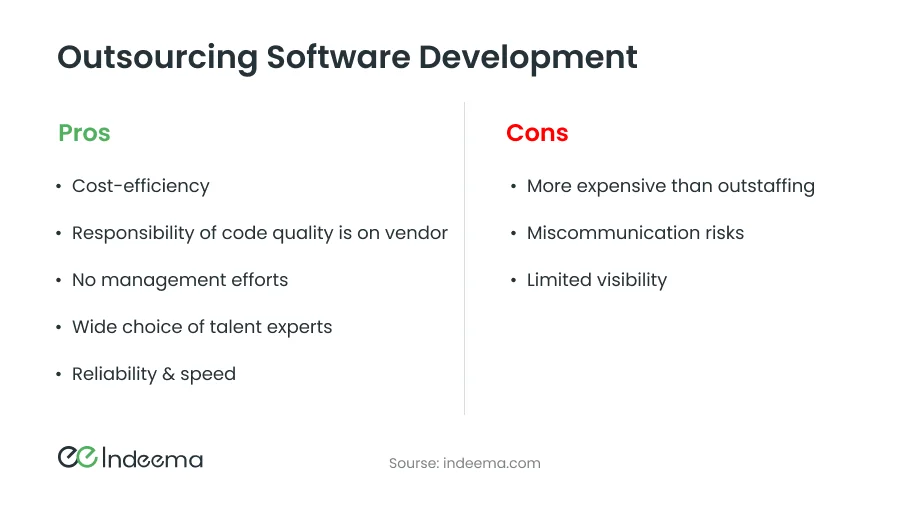
4. When to consider Outsourcing
The other decision is whether or not your project requires your team to learn new skills. For instance, if it'll require them to take on an IoT project, then outstaffing might not be the right fit as your own team will need time to become experts in this new domain. In this case, you'd want to work with an outsourced team that specializes in IoT and can dedicate all their resources to your project.
Cost is also a key driver when it comes to outsourcing. Data shows that outsourcing helps companies save close to 15% annually on labor costs. To put that into perspective, an organization with 10 employees will save around $150K each year by outsourcing just one of their functions.
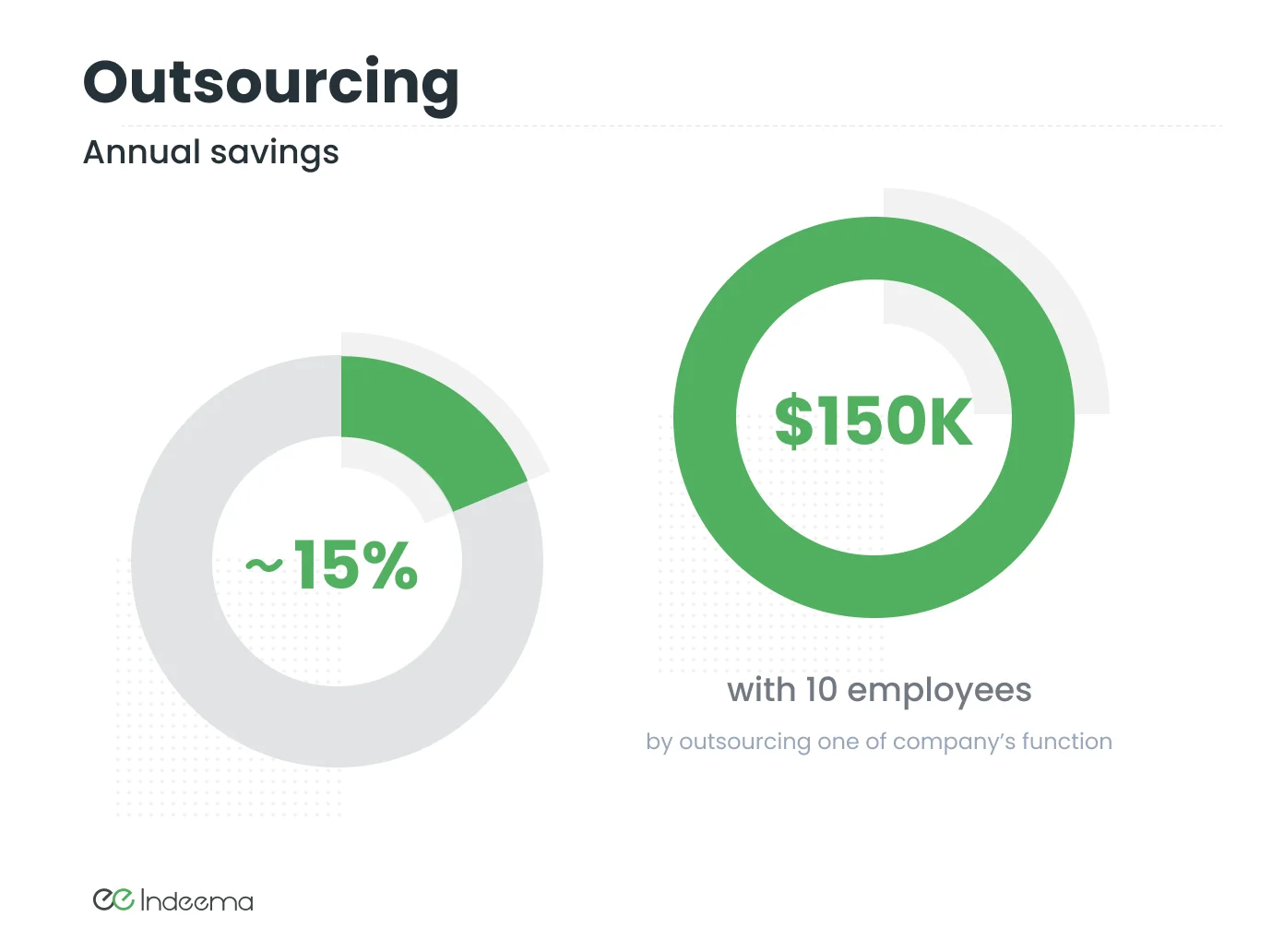
With outsourcing, companies can often add skills faster as they can hire experts from around the world. If there is a problem with internal employees, you're stuck working through HR and company policies to address any issues. In addition, if your internal team doesn’t have the necessary knowledge, additional time and money on training and upskilling is required.
With an outsourced team, companies can focus on hiring product specialists and experts that have skills and knowledge appropriate to the project.
Outsourcing also allows for maximum use of team members' skill sets and expertise since you get access to highly-skilled professionals who are very good at what they do instead of using internal employees who aren't working at full capacity because they have multiple roles. This results in higher productivity.
5. Outstaffing model - what it is and how does it work
In an earlier article, we talked in-depth about IT outsourcing and why it’s continuing to grow in popularity for companies worldwide. However, outsourcing isn't the only option, and many businesses are looking at outstaffing to accomplish their goals.
Outsourcing vs Outstaffing have many similarities, with the biggest being the use of external employees that perform the work. However, a key difference is that with outstaffing, you're often expanding on your own in-house capabilities. In this way, outstaffing can complement existing skills and knowledge, helping to further the capabilities of internal teams.
An outstaffing approach can be a good choice for many small and medium companies as outstaffing employees can be based in locations throughout the world.
6. Pros of outstaffing software development
6.1 People and Culture
The main difference between outsourcing and outstaffing is that with outstaffing, there's no necessity to manage employment issues as all of these duties are handled by the vendor directly.
There's no need for hiring or firing because the staff is on assignment from an agency that sources, hires and looks after all HR issues on your behalf. Companies need to follow all local laws and regulations when it comes to in-house staff, but with outstaffing there is more flexibility.
With in-house staff, businesses must consider their staff's paid holidays, security retirement benefits, dismissal rules, and so on. Outstaffing removes all of these requirements from a business's plate, letting them focus on overall productivity.
6.2 Project Quality and Throughput
With outsourcing, the quality may vary depending on your vendor and their skills. As you don't have complete oversight into who is doing the work, you're dependent on your outsourcing vendor to manage their resources well.
With outstaffing, you can select top IT professionals who are dedicated to you for specific projects or on an ongoing basis. That way, you guarantee consistent quality and high throughput without delays caused by a lack of staff. All you will need to worry about is a coordinator that can manage workload and overall quality.
6.3 Lower Costs
Outstaffing and outsourcing are both areas in which a business can save money versus hiring complete in-house teams. Outsourcing is a bit more expensive than outstaffing, but with outsourcing companies can completely remove themselves from the equation. This is often a very good strategy for companies with little to no experience in the field.
Outstaffing on the other hand is also a cost saver, and could help companies save more than outsourcing. However, with outstaffing, the resources that you gain access to, are joining an existing internal team. Outstaffing helps to keep these costs contained.
With outstaffing, new resources can be hired from around the world which can help to drive down prices.
6.4 Full access and control
The answer to the question of what outstaffing is and why you would desire to work this way is to have more daily, hands-on management. You serve in the role of the project manager in this outstaffing approach. You manage the resources. You are in charge of the development process' quality control.
7. Cons of outstaffing software development
7.1 Project Delivery
While outstaffing lets staff work with existing resources on project delivery, this also means the success of a project is purely dependent on that internal team. If an additional team isn't familiar with the project, there's more of a risk that it won't be successfully delivered. A key document that needs to be in place in this case is a project specification, which helps to make sure all teams are informed and on the same page.
7.2 Finding Skilled Resources
While the vendor is responsible for finding a resource with the right skills for a project, it's incumbent on the company to vet those resources thoroughly. Just because a resource has the skills doesn't mean they'll "fit" in your environment. This is the responsibility of both the client and vendor.
7.3 Overall Expertise
If a skill is too far outside the scope of the core team, it's better to outsource it because it'll be difficult for them to learn that skill in a timely fashion. For example, a mobile app development team might not have any experience with IoT development. If they are approached with an IoT project, it'll be better to outsource the development rather than expect them to learn about IoT within a few months.
With outsourcing, you are putting your trust in experts in what they do, allowing you time to focus on other areas where you can maximize your value-add.
8. When to consider Outstaffing
One way of helping you decide is if you already have an established development process in place. If so, you may be well suited for outstaffing as the new resources you bring onboard will help increase your overall skill base. This model works especially well if you are looking to do agile development.
Suppose your company is growing fast and decides that it needs additional resources but cannot justify hiring teams across all departments. In that case, outstaffing might be a good solution since hiring professionals for specific projects helps optimize resources. This model works well for a number of businesses in different areas such as …
When an in-house team is unable to meet current project deadlines or when they must quickly launch a new project while dealing with other IT chores, outstaffing teams become particularly useful.
By partnering with an outstaffing organization, companies can reduce the time it takes to bring their projects to market since they won't have to search for the expertise they need to complete a project.
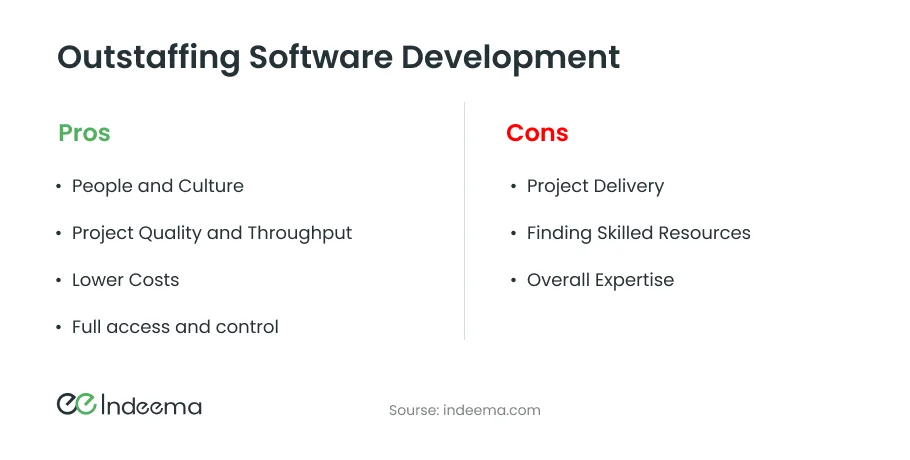
9. Outsourcing vs Outstaffing - detailed comparison
Outstaffing vs Outsourcing: what will you choose? These two terms are often confused for one another, so let's help make things more transparent. There are many definitions of the concepts of outsourcing and outstaffing, but it can be summarized relatively easily as follows:
Outsourcing is when a company lets an external agency look after the entire IT or IoT project.
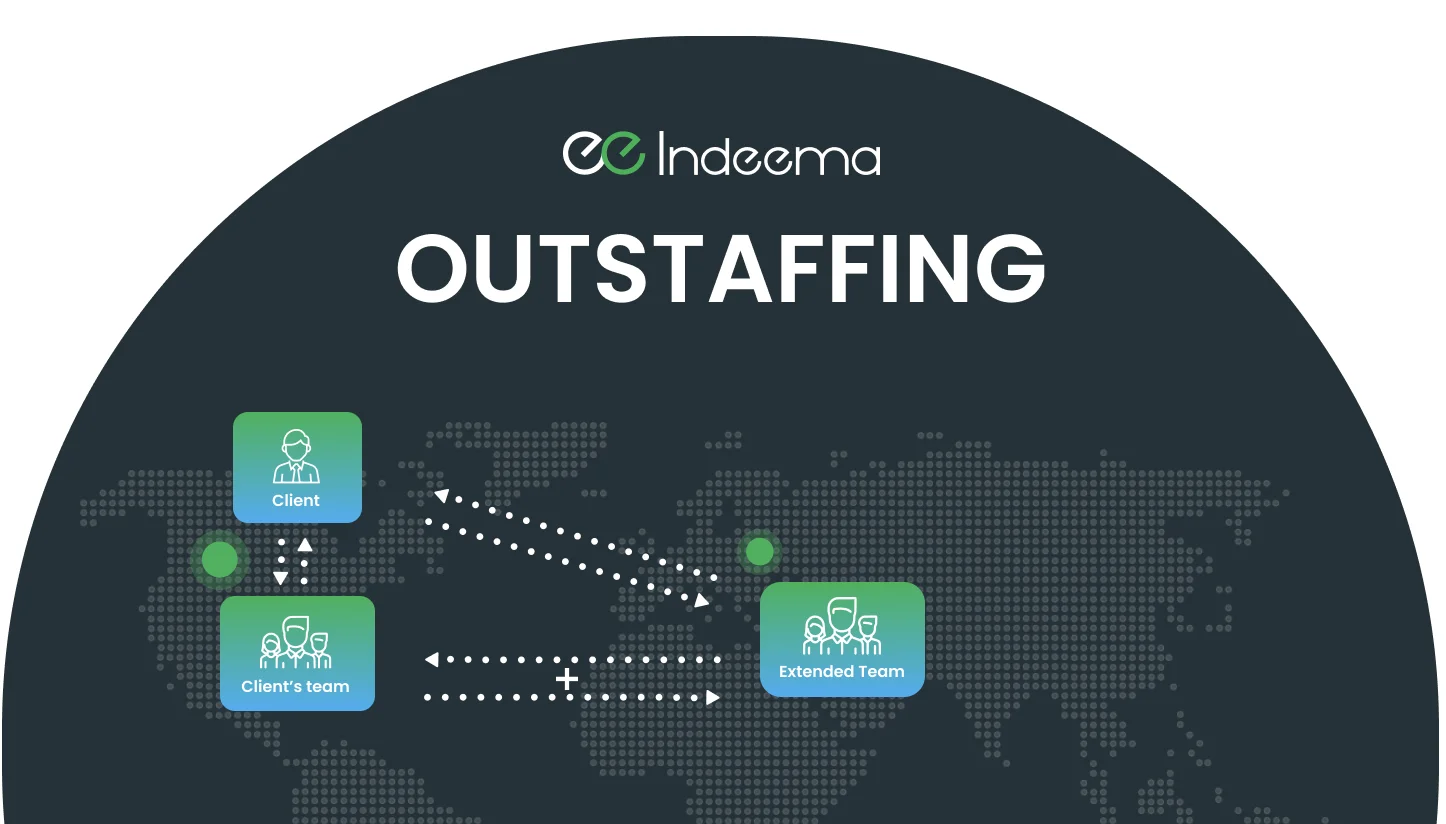
Outstaffing is different as it consists of hiring dedicated resources that work with your own internal teams to improve your overall capabilities.
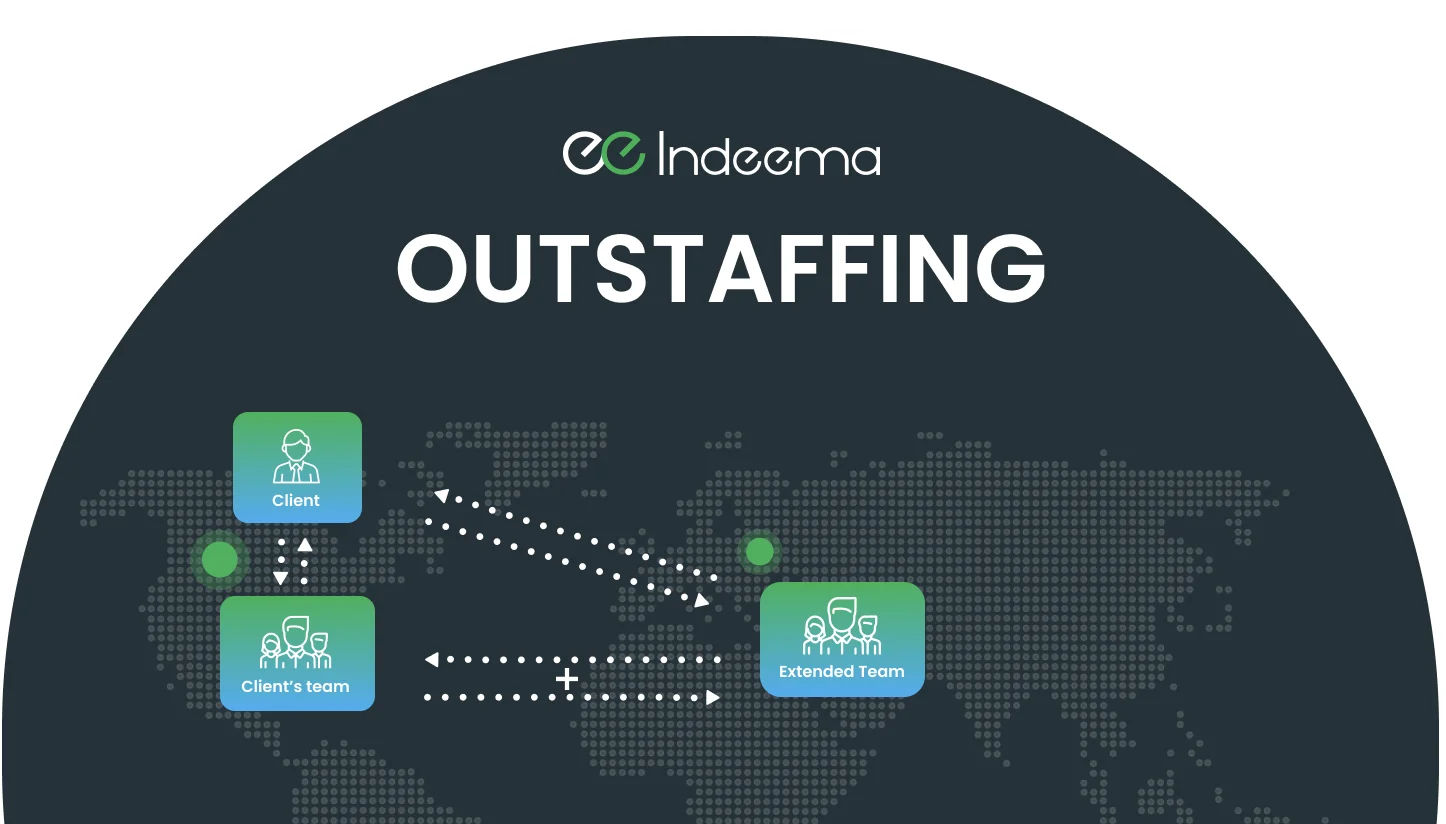
With outstaffing, these remote employees become a part of your company. They are managed by the same group of in-house managers and have the same objectives as your own employees.
With outstaffing, costs remain under control as you do not have to hire new employees and just pay an hourly rate for their services. This can be a particularly attractive option if you need additional qualified staff but don’t want full-time workers on your payroll. Even better, you can easily switch from one expert to another depending on tasks available or skills needed at the time.
Outstaffing lets the company retain overall responsibility and oversight for the entire project, while outsourcing puts that responsibility on the supplier.
According to Grand View Research, the value of outsourcing and outstaffing worldwide is expected to reach $936 billion by 2027. This is an annualized increase of close to 8%.

As you can see, there are many benefits for businesses looking at services like this, and over time, many companies are going to move towards an outstaffing model.
Outsourcing was primarily a cost-cutting strategy, while outstaffing looks at things differently. With outsourcing, its major selling feature is financial, whereas outstaffing has a different goal - providing top talent at an accessible price — a small yet very significant difference.
Conclusion
Both models have their pros and cons and it's important to truly understand your requirements and needs before making a choice. This is where an experienced vendor like Indeema Software can help.
Our team is a well-established and recognized market leader with years of experience and an impressive track record. At Indeema Software, we've delivered complex solutions using IoT, Mobile, and Web technologies.
We can work with you to help staff your own dedicated outstaffing team that will work closely with your own internal teams. We'll help you select each member to make sure they are an appropriate fit based on your project and skill requirements. We'll take care of all of the HR issues including hardware, recruitment and workplace, letting you focus on getting the best possible use from them.
Alternatively we can address any outsourcing requirements you might have if you want to take a completely hands-off approach. With us, you can get a dedicated team of experts who will take care of all aspects of a project from start to finish, regardless of how complex the job might be.
Making the final decision can be quite difficult, but with Indeema Software you don’t have to. Contact us for more information and let us help you choose the option that will work best for your requirements.
_1668678102865.webp)

